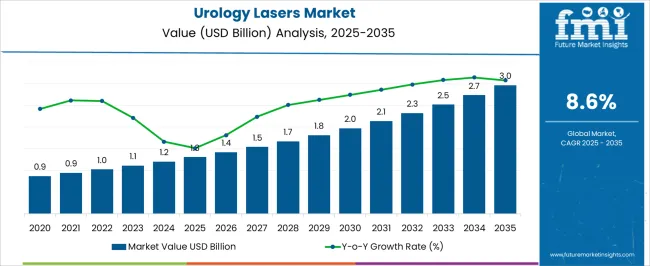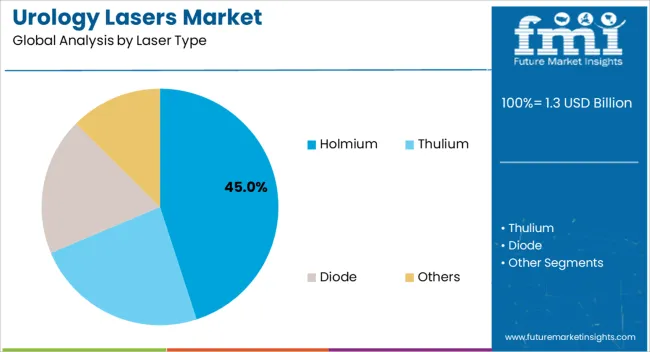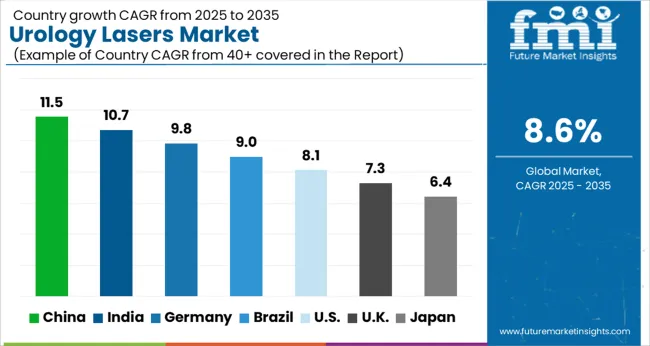The Urology Lasers Market is estimated to be valued at USD 1.3 billion in 2025 and is projected to reach USD 3.0 billion by 2035, registering a compound annual growth rate (CAGR) of 8.6% over the forecast period.

| Metric | Value |
|---|---|
| Urology Lasers Market Estimated Value in (2025 E) | USD 1.3 billion |
| Urology Lasers Market Forecast Value in (2035 F) | USD 3.0 billion |
| Forecast CAGR (2025 to 2035) | 8.6% |
The Urology Lasers market is experiencing steady growth driven by the increasing prevalence of urinary tract disorders, kidney stones, and prostate-related complications across both developed and emerging regions. Rising adoption of minimally invasive procedures and the growing preference for outpatient surgical solutions are shaping the market dynamics.
The market outlook is further strengthened by technological advancements in laser systems that offer higher precision, reduced procedure times, and lower risk of complications. Investments in healthcare infrastructure, increasing availability of urological care facilities, and the rising focus on patient comfort and faster recovery are contributing to market expansion.
Additionally, the growing awareness among patients and clinicians about the benefits of laser-based urological procedures over traditional surgery is expected to drive further adoption As healthcare systems continue to evolve with an emphasis on efficiency, safety, and cost-effectiveness, the Urology Lasers market is positioned for consistent growth, with opportunities for expanding clinical applications and innovative laser technologies that address diverse urological conditions.

The Holmium laser segment is projected to hold 45.0% of the Urology Lasers market revenue share in 2025, making it the leading laser type. This dominance is being attributed to its versatility and proven efficacy in treating a wide range of urological conditions, including kidney stones, urinary tract obstructions, and benign prostatic hyperplasia.
Adoption has been driven by the precision and minimal invasiveness of Holmium lasers, which allow procedures to be performed with reduced patient discomfort, lower complication rates, and faster recovery times. The growth of this segment has been reinforced by increasing clinical confidence in Holmium lasers due to their ability to effectively fragment stones of varying sizes and compositions while minimizing thermal damage to surrounding tissues.
Moreover, the segment benefits from the expanding number of urology centers equipped with advanced laser systems and the growing emphasis on outpatient surgical procedures that reduce hospital stays and overall treatment costs The continuous development of compact and efficient Holmium laser devices has further accelerated adoption, positioning this segment as a key contributor to the overall market growth.
The revenue generated by the urology lasers market witnessed a significant increase from 201.38 to 2025, driven by the growing demand for advanced urological treatments and the adoption of minimally invasive procedures.
As per the FMI study, the urology lasers industry garnered revenue of USD 1.3 billion in 2025 and grew at a 1.32.2% rate from 201.38 to 2025.
The demand outlook for urology lasers is expected to experience a substantial surge. This can be attributed to various factors, including the rising global prevalence of urological disorders, an increasing aging population, technological advancements in laser-based therapies, and a shift towards non-invasive treatment options.
These factors collectively indicate a promising future for the urology lasers industry, with strong growth potential of 9.0% from 2025 to 2035, reaching USD 3 billion by 2035.

China, with its vast population and increasing prevalence of urological disorders, is projected to offer a multitude of opportunities for the urology lasers market.
The country's growing healthcare infrastructure, rising disposable income, and expanding middle class contribute to increased demand for advanced urological treatments. Additionally, the Chinese government's initiatives to enhance healthcare access and improve medical technology further support market growth.
The rising awareness among healthcare professionals and patients regarding the benefits of urology lasers, coupled with favorable reimbursement policies, creates a conducive environment for market expansion.
China presents a promising landscape for urology laser manufacturers and providers to tap into a vast patient base and establish a strong presence in this rapidly growing market, moving ahead with 8.9% from 2025 to 2035, touching USD 3 million by 2035.
According to the NCBI, fluid, and calcium consumption have a substantial role in the development of urinary stones, causing urolithiasis in 50% of United States patients.
As per FMI, the United States of America offers a promising growth outlook for the urology lasers industry, with a market share of USD 468.2 million by 2035.
The emphasis on minimally invasive procedures and the adoption of innovative medical technologies drive the adoption of urology lasers. Furthermore, ongoing research and development activities, collaborations between industry players and academic institutions, and a strong regulatory framework foster innovation and support the introduction of new urology laser devices.
The United States hence presents a favorable market landscape for urology laser manufacturers, with ample opportunities for growth and advancement in this dynamic industry.
The holmium systems market is expanding as a result of their effectiveness and safety in treating patients without a surgical procedure, in turn, securing a CAGR of 8.9% during the forecast period.
A minimally invasive procedure is favored for the removal of tissues that obstruct urine flow via the prostate, and this is the principal application for which the holmium laser is utilized.
Due to its safety and efficiency in treating patients without an incision process, holmium systems are becoming increasingly popular.
Depending on the size of the prostate, the treatment can take anywhere from 45 to 90 minutes. Patients can be released from the hospital on the same day because this surgery is less intrusive. It is anticipated that these elements may increase demand for urology lasers.
By 2035, the Benign Prostatic Hyperplasia category is anticipated to advance at 8.8% from 2025 to 2035. The development can be due to elements like inactivity, excess weight, and a diet rich in red meat and fat, which may raise the risk of BPH.
Benign Prostatic Hyperplasia (BPH) is predicted to lead the market by application due to several key factors. Firstly, BPH is a common condition among aging males, with a high prevalence globally.
As the population continues to age, the incidence of BPH is expected to rise, creating a growing patient pool.
Secondly, urology lasers offer an effective and minimally invasive treatment option for BPH, providing precise tissue ablation and improved patient outcomes.
The advantages of urology lasers, such as reduced bleeding, shorter hospital stays, and faster recovery times, make them an attractive choice for BPH treatment.
A few prominent firms dominate the market for urology lasers, which is only moderately competitive. Currently, a select few big businesses control the majority of the market in terms of market share.
To maintain their position in the worldwide market, the top companies are engaged in a variety of strategic alliances, including acquisitions and the introduction of new products.
Along with developing cutting-edge laparoscopic urological gadgets, the participants concentrate on analyzing technical developments and putting growth tactics like mergers and acquisitions into practice.

Recent Developments in the Market:
The global urology lasers market is estimated to be valued at USD 1.3 billion in 2025.
The market size for the urology lasers market is projected to reach USD 3.0 billion by 2035.
The urology lasers market is expected to grow at a 8.6% CAGR between 2025 and 2035.
The key product types in urology lasers market are holmium, thulium, diode and others.
In terms of , segment to command 0.0% share in the urology lasers market in 2025.






Full Research Suite comprises of:
Market outlook & trends analysis
Interviews & case studies
Strategic recommendations
Vendor profiles & capabilities analysis
5-year forecasts
8 regions and 60+ country-level data splits
Market segment data splits
12 months of continuous data updates
DELIVERED AS:
PDF EXCEL ONLINE
Urology Supplements Market Size and Share Forecast Outlook 2025 to 2035
Urology Imaging Systems Market Size and Share Forecast Outlook 2025 to 2035
Urology Disposables Market
Neurology Clinical Trials Market Size and Share Forecast Outlook 2025 to 2035
Neurology Services Market Overview - Growth & Forecast 2025 to 2035
Neurology Digital Therapeutics Market Growth – Trends & Forecast 2024-2034
Nephrology and Urology Incontinence Devices Market Growth – Trends & Forecast 2025 to 2035
Dental Lasers Market Growth – Industry Insights & Forecast 2024-2034
Cosmetic Lasers Market
Surgical Lasers Market
Ultrafast Lasers Market Analysis - Industry Growth & Forecast 2025 to 2035
Veterinary Lasers Market Size and Share Forecast Outlook 2025 to 2035
Ophthalmic Lasers Market Analysis - Innovations & Forecast 2024 to 2034
Dermatology Lasers Market - Demand, Innovations & Forecast 2025 to 2035
Solid State Lasers Market Analysis - Growth & Forecast 2025 to 2035
Pulmonology Lasers Market
Mid-infrared Lasers Market Analysis - Growth & Trends 2025 to 2035
Semiconductor Lasers Market Insights – Trends, Growth & Forecast 2025 to 2035
Carbon Dioxide Lasers Market Size and Share Forecast Outlook 2025 to 2035
Quantum Cascade Lasers Market Growth - Trends & Forecast 2025 to 2035

Thank you!
You will receive an email from our Business Development Manager. Please be sure to check your SPAM/JUNK folder too.
Chat With
MaRIA